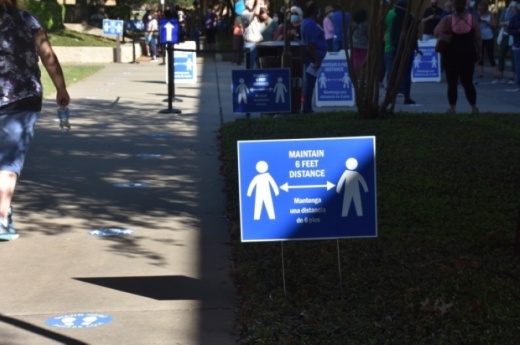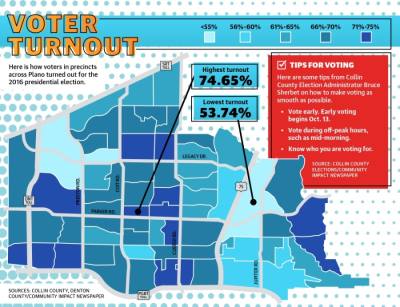Polls opened for early voting in Plano and McKinney on Oct. 13. Election officials expect a record number of voters due to an increase in registration in Collin County as well as high interest in some of this year’s races. To prepare, the county has upped the number of early voting locations by nearly 20% as well as Election Day vote centers by 40% compared with the 2016 presidential election, according to Collin County Elections Administrator Bruce Sherbet.
But increased turnout is just one factor driving the county’s decision to add more polling places. Its leaders hope the changes will also lead to smaller crowds and increased social distancing.
“Our biggest objective was to have a safe environment—as safe as possible—in our polling places, for our poll workers and for our voters,” Sherbet said.
State and local leaders have taken steps to try and minimize the inconveniences posed by the pandemic. Earlier this summer, Gov. Greg Abbott announced that the early voting period would be extended by six days. Collin and Denton counties are also allowing eligible residents to vote curbside.
Despite these allowances, some party leaders believe not enough has been done to encourage participation in the November election. For example, in Texas, only certain residents are eligible to vote by mail.
Safeguards put into place by state and local government to make the process simpler are not enough, said Mike Rawlins, Collin County Democratic Party chair.
“I am encouraged that the governor did add another week to early voting,” Rawlins said. “But as far as our county goes, we have not significantly extended the early voting hours to make it easier for people to vote.”
The eradication of straight-ticket voting following a change in state law that went into effect this year is another significant change to this year’s election. Voters who previously would have marked a single party for their entire ballot will now have to select a candidate in each individual race.
In-person voters are advised to come prepared with who they plan to vote for, to vote during off-peak hours and to cast their ballots early.
“The goal is to try to ... get people ... in and out as quickly as possible, but not [to rush] them if they want to take time to spend at that machine a little bit longer,” Sherbet said.
Taking every precaution
Logistical challenges associated with social distancing and sanitation are driving up costs and forcing officials to rethink the layout of the typical polling location. The July primary runoff was a good first run and helped the county prepare for November, Sherbet said.
Collin County has spent about $250,000 on additional voting equipment, such as ballot counters and curbside voting devices, Sherbet said. The county has also received an additional $1.2 million in grants for the election. The full cost of the election will not be known until after Election Day, he added.
“I would say, easily, it could increase it by 50% or double the cost, possibly, when it’s all said and done,” Sherbet said.
The virus has also prompted a greater number of eligible voters to apply to vote by mail. As of Oct. 12, Collin County distributed about 33,000 mail-in ballots, which is up from the 21,000 mail-in ballots it received during the 2016 presidential election, Sherbet said. The county expects to receive somewhere between 35,000 to 40,000 applications by the Oct. 23 deadline, he added.
Neal Katz, executive director of the Collin County Republican Party and chair of the Collin County Ballot Board, said he spent time ahead of this election reassuring voters that their mail-in ballots will count. In years past, the typical rejection rate in the county has been one ballot per 1,000 cast, he said.
“It’s not that much,” he said. “Our aim is to make sure every vote counts if it’s done correctly and fairly.”
The Collin County Republican Party is also emphasizing to its members the availability of curbside voting, Katz said.
“It’s really important that we let people know they have that option,” he said.
The lead-up to the election has also looked different this year. Instead of knocking on doors and talking to voters in person, volunteers with the Collin County Democratic Party have turned to making phone calls and texting, Rawlins said.
“[In-person campaigning] kind of goes contrary to taking the pandemic seriously and is not the kind of behavior that they want people to engage in,” Rawlins said. “So, the bottom line is, we’re not doing a lot of [the] face-to-face, ... traditional outreach that we had been doing.”
What to expect
Despite the surge in mail-in ballots, Rawlins said he believes that eagerness to participate in what some voters have called a historic election will likely outweigh concerns around the coronavirus.
“My guess is that if this were a normal year, the pandemic would probably depress turnout. But it is not a normal year,” he said.
Collin County Republican Party officials agreed that the pandemic is unlikely to deter voters.
“Collin County really turns out heavily,” Katz said. “I’m expecting 400,000 people to vote.”
Collin County allows residents to cast ballots at any county polling location during early voting and on Election Day. Voters can check the estimated wait time at each location by visiting the county’s website.
Sherbet said his staff is encouraging voters to check their sample ballot before heading to the polls.
Collin County had more than 1,000 poll workers signed up as of mid-September, and roughly 200 more were expected to sign up by the time early voting began Oct. 13, Sherbet said.
“This year, we’ve had a fairly good number—more than I remember—of people volunteering to work in a polling place,” he said.
Olivia Lueckemeyer contributed to this report








